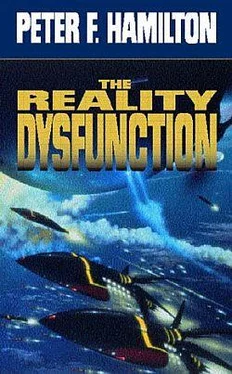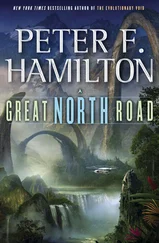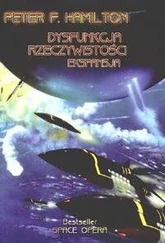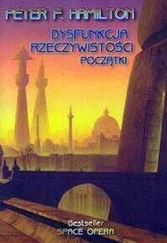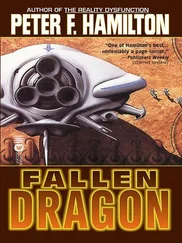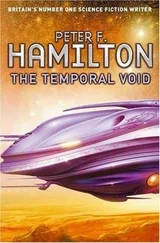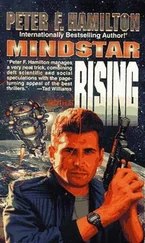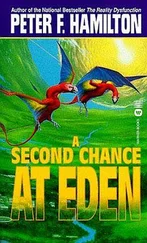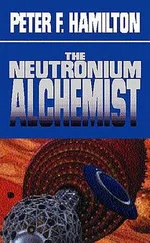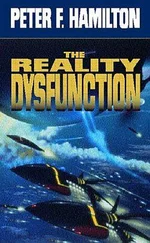The tidal-locked Ly-cilph world coasted along seventy thousand kilometres above the tenuous outer fringes of the magnetosphere, beyond the reach of the worst radiation. Occasional palpitations within the flux lines would bombard the upper atmosphere with protons and electrons, sending squalls of solar-bright borealis lights slithering and twisting silently across the rusty sky.
Atmospheric composition was an oxygen-nitrogen mix, with various sulphurous compounds, and an inordinately high water-vapour level. Mist, fog, and stacked cloud layers were the norm. Proximity to the infrared glow of the supergiant gave it a perpetual tropical climate, with the warm, wet air of the nearside constantly on the move, rushing around to the farside where it cooled, radiating its thermal load away into space, and then returning via storms which traversed the poles. Weather was a drab constant, always blowing, always raining, the strength of the gusts and downpours dictated by the orbital location. Night fell in one place, at one time. On the farside, when supergiant and planet were in an inferior conjunction, and the hellish red cloudscape eclipsed the nearside’s brief glimpse of the sun.
It was a cycle which was broken only once every nine years, when a new force was applied to the timeless equation. A four-moon conjunction, which brought chaos and devastation to the surface with storms of biblical ferocity.
The warmth and the light had incubated life on this world, as they had on countless billions throughout the universe. There had been no seas, no oceans when the first migratory interstellar germ fell onto the pristine planet, rooting its way into the mucky stain of chemicals infecting the bubbling muddy waters. Tidal forces had left a smooth surface, breaking down mountains, grinding away at the steppes left over from the time of formation. Lakes, rivers, and flood plains covered the land, steaming and being rained on. There was no free oxygen back then, it was all combined with carbon. A solid stratum of white cloud ensured the infrared radiation found it hard to escape, even in the centre of the farside. Temperatures were intolerably high.
The first life, as always, was algae, a tough slime which spread through the water, seeping down rivers and streams to contaminate the lakes, hurried through the air by the tireless convection currents. It altered and adapted over geological eras, slowly learning to utilize the two contrasting light sources as an additional energy supply. Success, when it came, was swift, mere millennia. Oxygen poured forth. Carbon was digested. The temperature fell. The rain quickened, thinning the clouds, clearing the sky. Evolution began once more.
For millions of years, the planet’s governing nine-year cycle was of no importance. Storms and hurricanes were an irrelevance to single-cell amoebas floating sluggishly through the lakes and rivers, nor did they matter to the primitive lichens which were creeping over the rocks. But the cells adrift in the water gradually began to form cooperative colonies, and specialization occurred. Jelly-like worms appeared in the lakes, brainless, instinct-driven and metabolically inefficient, little more than mobile lichen. But it was a start. Birth and death began to replace fission as the premier method of reproduction. Mutations crept in, sometimes producing improvements, more often resulting in inviability. Failed strains were rapidly culled by merciless nature. Divergence appeared, the dawn of a million species; DNA strands lengthened, a chemical record of progress and blind alleys. Crawling creatures emerged onto the lakesides, only to be scalded by the harsh chemicals making up the atmosphere. Yet they persisted.
Life was a steady progression, following a pattern which was as standard as circumstances would allow. There were no such things as ice ages to alter the direction which this world’s creatures were taking, no instabilities causing profound climate changes. Only the nine-yearly storms, appearing without fail, which became the dominant influence. The new animals’ breeding cycles were structured around it, plant growth was restricted by it.
The planet matured into a jungle world, a landscape of swamps and lush verdancy, where giant ferns covered the surface from pole to pole, and were themselves webbed and choked with tenacious creepers reaching for the clear sky. Floating weeds turned the smaller lakes into vast marshlands. Elaborate ruff flowers vied for the attention of insects and birds, seed pods with skirts of hardened petals flew like kites through the air. Wood was non-existent, of course, wood required decades of uninterrupted growth to form.
Two wildly different flora genealogies sprang up, with the terminator as an unbreachable dividing line, and battleground. Farside plants adapted to the sun’s yellow light: they were capable of tolerating the long nights accompanying conjunction, the cooler temperatures. Nearside was the province of red light, falling without end: its black-leafed plants were taller, stronger, more vigorous, yet they were unable to conquer farside. Night killed them, yellow light alone was insufficient to drive their demanding photosynthesis, and the scattered refraction of red light by the thick atmosphere never carried far enough, haunting the land for a couple of hundred kilometres beyond the terminator.
The animals were more adaptive, ranging freely across farside and nearside. Dinosaur-analogues never appeared, they were too big, requiring too much time to grow. Apart from bird-analogues, lizard creatures with membranous wings, most animals were smallish, reflecting their aquatic heritage. All were cold-blooded, at home in the muddy streams and weed-clogged pools. They retained that ancestral trait out of pure necessity. For that was where their eggs were laid, buried deep and safe in the mud of the lakebeds, hidden away from the worst ravages of the storm. That was how all life survived while the winds scoured the world, as seeds and eggs and spores, ready to surge forth when stability returned in a few short weeks.
On such an inimical world life can evolve in one of two ways. There are the defeated, littered on countless planets across the cosmos, weak, anaemic creatures huddled in their dead-end sanctuaries, a little protective niche in the local ecology, never rising above a rudimentary level, their very lack of sophistication providing them with the means of continuation. Or there are the triumphant, the creatures which refuse to be beaten, which fight tooth and nail and claw and tentacle against their adversity; those for which circumstances act as an evolutionary spur. The dividing line is thin; it might even be that a devastating storm every eight years could bring genetic ruination. But nine years . . . nine proved enough time to ensure survival, allowing the denizens to rise to the challenge rather than sink back into their ubiquitous mires.
The Ly-cilph claimed such a victory. A mere eight hundred million years after life had begun on their world they had reached their pinnacle of evolution. They became transcendent entities.
Their nine-year cycle starts in a fish form, hatching from the black egg-clusters concealed below the mud. Billions of free-floating slugs emerge, two centimetres long, and are eaten by faster, meaner predators as they gorge themselves on the abundant sludge of decayed vegetation putrefying in the water. They grow and change over three years, losing their tails, developing a snail-like skirt. They cling to the bottom of their lakes, an ovoid body ninety centimetres high, with ten tentacles rising up from the crown. The tentacles are smooth, sixty centimetres long, devoid of suckers, but with a sharp curved horn on the tip; and they’re fast, exploding like a nest of enraged pythons to snatch their ignorant prey swimming overhead.
When their full size has been reached they slide up out of the water to range through the planetwide jungle. Gills adapt to breathe the harsh musky air, tentacle muscles strengthen to support the drooping limbs away from the water’s cosy buoyancy. And they eat, rummaging through the matted undergrowth with insistent horns to find the black, wizened nutlike nodes that have been lying there neglected since the storm. The nodes are made up of cells saturated with chemical memory tracers, memories containing information, the knowledge accumulated by the Ly-cilph race throughout time. They bring understanding, an instant leap to sentience, and trigger the telepathic centre of their brains. Now they have risen above a simple animal level of existence they have much to converse about.
Читать дальше
